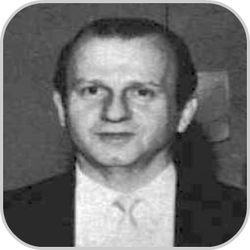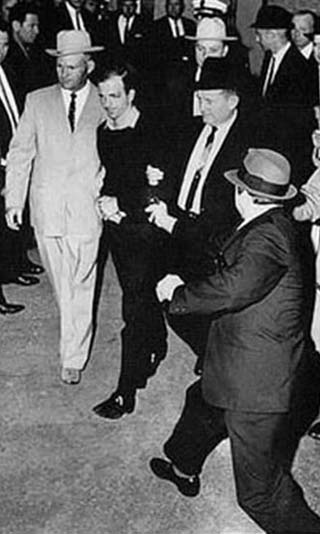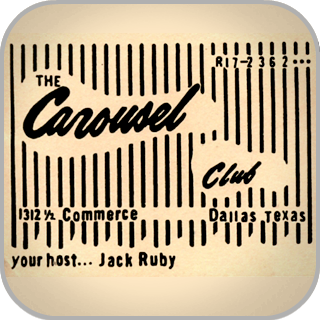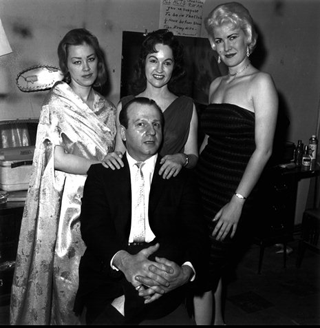
Jack Ruby:
Talk about conflicted characters. A friend of both Dallas police and the Mob if not a mobster himself, Jack Ruby is hands-down one of the most compelling characters in this story.
Ruby owned and operated two Dallas nightclubs, notably the Carousel Club, a seedy downtown burlesque joint where police officers and the underworld rubbed elbows. The Carousel Club was a place where patrons could drink after hours while Dallas police looked the other way.
Ruby ran the joint and served as master of ceremonies on stage. He was also happy to fill in as bouncer, a position in which he displayed a quick temper and notable violent streak. Ruby boasted about his tough-guy boxing days but he picked his targets carefully -- almost always those too drunk to defend themselves. After catching them by surprise and pummeling them, he typically sent them on their way with a a toss out the door and down stairs. Now long-gone, the Carousel Club is the nexus for conspiracy theorists looking for any number of connections between Ruby and the Mob, the Mob and law enforcement, or law enforcement complacency in the assassination.
Talk about conflicted characters. A friend of both Dallas police and the Mob if not a mobster himself, Jack Ruby is hands-down one of the most compelling characters in this story.
Ruby owned and operated two Dallas nightclubs, notably the Carousel Club, a seedy downtown burlesque joint where police officers and the underworld rubbed elbows. The Carousel Club was a place where patrons could drink after hours while Dallas police looked the other way.
Ruby ran the joint and served as master of ceremonies on stage. He was also happy to fill in as bouncer, a position in which he displayed a quick temper and notable violent streak. Ruby boasted about his tough-guy boxing days but he picked his targets carefully -- almost always those too drunk to defend themselves. After catching them by surprise and pummeling them, he typically sent them on their way with a a toss out the door and down stairs. Now long-gone, the Carousel Club is the nexus for conspiracy theorists looking for any number of connections between Ruby and the Mob, the Mob and law enforcement, or law enforcement complacency in the assassination.
Everything pertaining to what's
happening has never come to the surface. The world will never know the true
facts of what occurred, my motives. The people who had so much to gain, and had
such an ulterior motive for putting me in the position I'm in, will never let
the true facts come above board to the world. Jack Ruby, March 1965.
Born Jacob Rubenstein in Chicago in 1911, Ruby was an emotional fellow who shared an affinity for police officers and preferred the company of mobsters and professional gamblers. The Warren Commission claimed to find no link between Ruby and the Mob and ultimately ruled that Ruby had acted alone in killing Oswald in the basement of the Dallas police headquarters on Nov. 24. The motive according to the commission: he was simply distraught by the assassination and the prospect that Jackie Kennedy would have to return to Dallas and testify on Oswald’s trial.
Meanwhile, the House Select Committee on Assassinations also explored Ruby’s underworld ties and reached quite a different conclusion. The HSCA found in 1978 that Ruby in fact was closely tied to Chicago mobster Sam Giancana and Dallas figures like Joseph Civello and Joseph Campisi. In fact, Ruby visited Campisi’s Egyptian Room restaurant on Mockingbird Lane the day before Kennedy was assassinated. After his arrest for Oswald’s death, Campisi was one of Ruby’s first jailhouse visitors.
Ruby was close professional gambler Lewis McWillie and visited Cuba at McWillie’s invitation in 1959. Regarding that Cuba trip bankrolled by McWillie, the HSCA figured Ruby was most likely serving as a “courier for gambling interests.” Like Oswald, Ruby knew hard times and a broken household as a kid, having grown up on the mean streets of Chicago. Interestingly, both he and Oswald spent time in an orphanage and their mothers each had mental problems.
Like many of the events surrounding this story, the shooting of Oswald by Ruby in the basement of the old Dallas police headquarters raises all kinds of questions. Of course he did it -- the whole world saw it on live TV. But how and why? Ruby apparently was in no hurry to get there even though it was widely known that Oswald was scheduled to be transferred to the Dallas County jail at 10 a.m. Leaving his dachsund in the car, Ruby first went to the Western Union office and wired $25 to one of his down-and-out burlesque dancers about 11:15 a.m. He then walked down the sidewalk and, apparently, down the ramp into the basement parking lot where more than 70 police officers and about 50 reporters had been waiting more than an hour for the transfer to occur.
Within moments of Ruby's arrival, Oswald was ushered out into the parking lot even though the car was not in place to take him to the jail. Still unanswered among the conspiracy crowd: did Ruby get assistance from Dallas police getting into the basement? Was the delivery of Oswald held up for an hour or more because they were waiting for Ruby's arrival?
Born Jacob Rubenstein in Chicago in 1911, Ruby was an emotional fellow who shared an affinity for police officers and preferred the company of mobsters and professional gamblers. The Warren Commission claimed to find no link between Ruby and the Mob and ultimately ruled that Ruby had acted alone in killing Oswald in the basement of the Dallas police headquarters on Nov. 24. The motive according to the commission: he was simply distraught by the assassination and the prospect that Jackie Kennedy would have to return to Dallas and testify on Oswald’s trial.
Meanwhile, the House Select Committee on Assassinations also explored Ruby’s underworld ties and reached quite a different conclusion. The HSCA found in 1978 that Ruby in fact was closely tied to Chicago mobster Sam Giancana and Dallas figures like Joseph Civello and Joseph Campisi. In fact, Ruby visited Campisi’s Egyptian Room restaurant on Mockingbird Lane the day before Kennedy was assassinated. After his arrest for Oswald’s death, Campisi was one of Ruby’s first jailhouse visitors.
Ruby was close professional gambler Lewis McWillie and visited Cuba at McWillie’s invitation in 1959. Regarding that Cuba trip bankrolled by McWillie, the HSCA figured Ruby was most likely serving as a “courier for gambling interests.” Like Oswald, Ruby knew hard times and a broken household as a kid, having grown up on the mean streets of Chicago. Interestingly, both he and Oswald spent time in an orphanage and their mothers each had mental problems.
Like many of the events surrounding this story, the shooting of Oswald by Ruby in the basement of the old Dallas police headquarters raises all kinds of questions. Of course he did it -- the whole world saw it on live TV. But how and why? Ruby apparently was in no hurry to get there even though it was widely known that Oswald was scheduled to be transferred to the Dallas County jail at 10 a.m. Leaving his dachsund in the car, Ruby first went to the Western Union office and wired $25 to one of his down-and-out burlesque dancers about 11:15 a.m. He then walked down the sidewalk and, apparently, down the ramp into the basement parking lot where more than 70 police officers and about 50 reporters had been waiting more than an hour for the transfer to occur.
Within moments of Ruby's arrival, Oswald was ushered out into the parking lot even though the car was not in place to take him to the jail. Still unanswered among the conspiracy crowd: did Ruby get assistance from Dallas police getting into the basement? Was the delivery of Oswald held up for an hour or more because they were waiting for Ruby's arrival?



